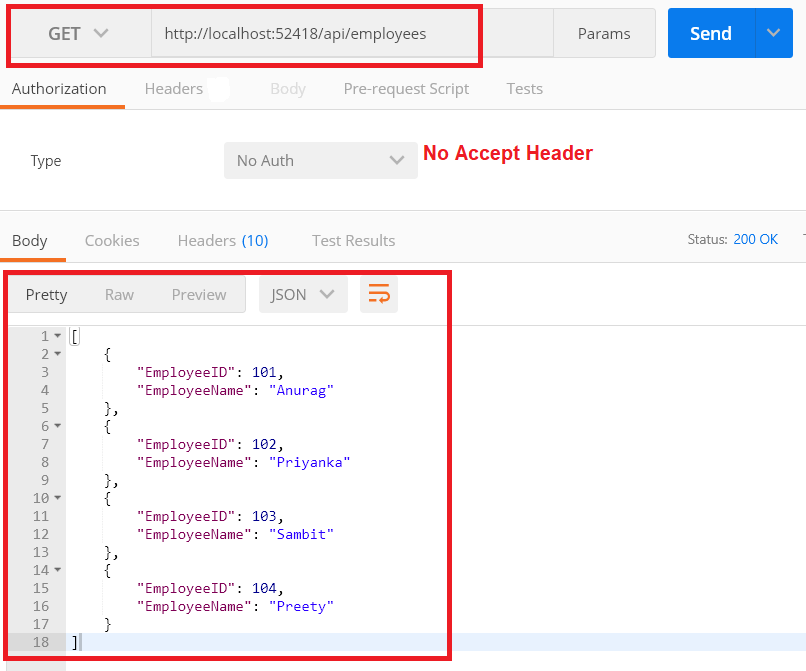Back to: ASP.NET Web API Tutorials For Beginners and Professionals
Web API Versioning Using Accept Header
In this article, I am going to discuss Web API Versioning Using Accept Header with an example. This is a continuation part of our previous article, so please read our previous article before proceeding to this article where we discussed Web API Versioning Using Custom Header.
What is the Accept Header?
The Accept header tells the server in which file format the browser wants the data. These file formats are generally called as MIME-types. The MIME stands for Multipurpose Internet Mail Extensions.
In the Content Negotiation in Web API article, we discussed that, if we want the Web API service to return data in XML format then we need to set the Accept header value to application/xml. Similarly, if we want the Web API service to return the data in JSON format then we need to set the Accept header value to application/json.
Implementing Web API Versioning using accept header
In our last article, we discussed how to create a custom header for versioning. So, instead of creating a custom header, which is used only for versioning purposes, we can make use of the built-in Accept header. Within the Accept header, we can add additional parameters to send the additional data along with the request to the server. For example, we can specify the version of the service that we want by using the version parameter as shown in the below image.

What we need to do here is, now we need to read the Version parameter value from the Accept header in our CustomControllerSelector class. So, modify the CustomControllerSelector class as shown below. The code is self-explained, so please read the comments.
using System.Linq;
using System.Net.Http;
using System.Web.Http;
using System.Web.Http.Controllers;
using System.Web.Http.Dispatcher;
namespace WebAPIVersioning.Custom
{
// Derive the CustomControllerSelector from the DefaultHttpControllerSelector class
public class CustomControllerSelector : DefaultHttpControllerSelector
{
private HttpConfiguration _config;
public CustomControllerSelector(HttpConfiguration config) : base(config)
{
_config = config;
}
public override HttpControllerDescriptor SelectController(HttpRequestMessage request)
{
// First fetch all the available Web API controllers
var controllers = GetControllerMapping();
// Get the controller name and the parameter values from the request URI
var routeData = request.GetRouteData();
// Get the controller name from route data.
// The name of the controller in our case is "Employees"
var controllerName = routeData.Values["controller"].ToString();
// Set the Default version number to 1
string versionNumber = "1";
// Get the version number from the Accept header
// Users can include multiple Accept headers in the request
// Check if any of the Accept headers has a parameter with name version
var acceptHeader = request.Headers.Accept.Where(a => a.Parameters
.Count(p => p.Name.ToLower() == "version") > 0);
// If there is atleast one header with a "version" parameter
if (acceptHeader.Any())
{
// Get the version parameter value from the Accept header
versionNumber = acceptHeader.First().Parameters
.First(p => p.Name.ToLower() == "version").Value;
}
if (versionNumber == "1")
{
// if the version number is 1, then append V1 to the controller name.
// So at this point the, controller name will become EmployeesV1
controllerName = controllerName + "V1";
}
else
{
// if version number is 2, then append V2 to the controller name.
// So at this point the controller name will become EmployeesV2
controllerName = controllerName + "V2";
}
HttpControllerDescriptor controllerDescriptor;
if (controllers.TryGetValue(controllerName, out controllerDescriptor))
{
return controllerDescriptor;
}
return null;
}
}
}
That’s it; we have done with our implementation. Run the application and then issue a request without the Accept header using the postman as the client, the service falls back to version 1 and returns version 1 employee objects in JSON format as expected as shown in the below image.

Now, specify the version parameter as part of the Accept header then you will get the response in the specified version as expected as shown in the below image.

In the next article, I am going to discuss how to implement the Web API versioning using Custom Media Types with an example. Here, in this article, I try to explain how to implement Web API Versioning Using Accept Header step by step with an example. I hope this article will help you with your needs. I would like to have your feedback. Please post your feedback, question, or comments about this article.
